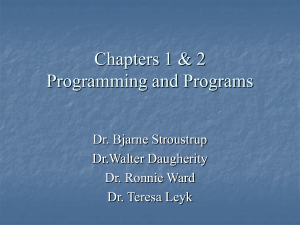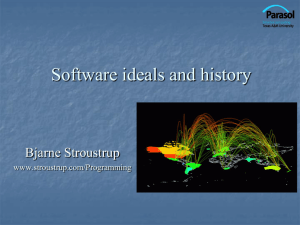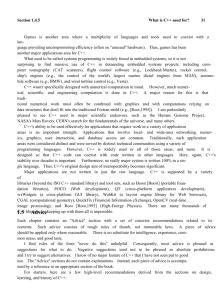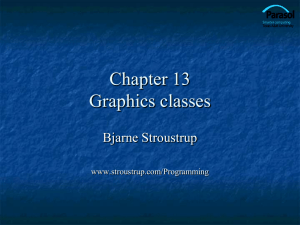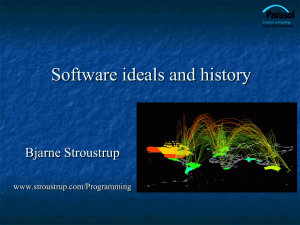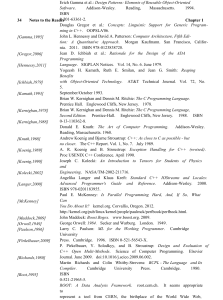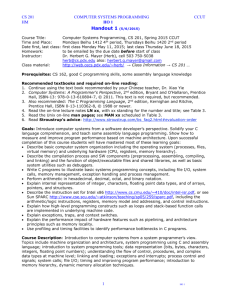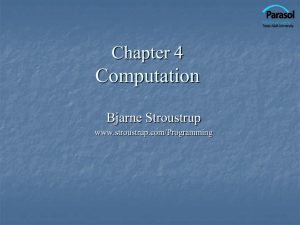Programming and - Bjarne Stroustrup
advertisement
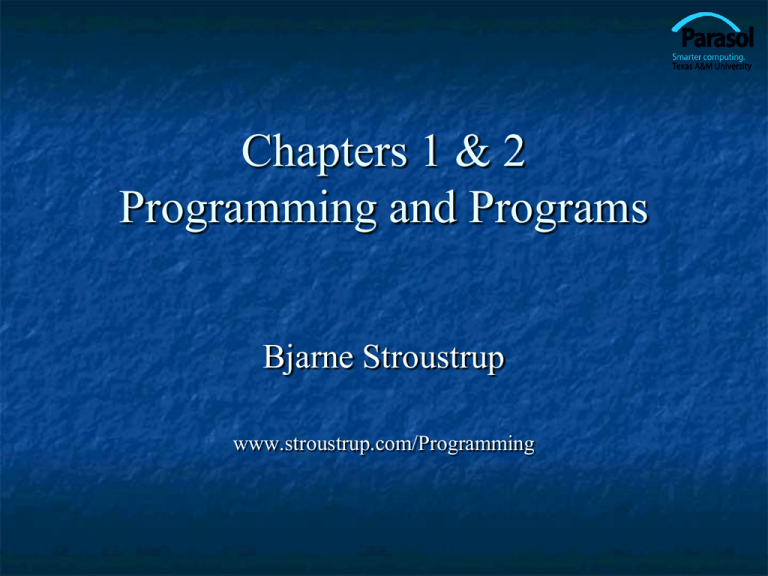
Chapters 1 & 2
Programming and Programs
Bjarne Stroustrup
www.stroustrup.com/Programming
Abstract
Today, we’ll outline the aims for this course and
present a rough course plan. We’ll introduce
the basic notion of programming and give
examples of areas in which software is critical
to our civilization. Finally, we’ll present the
simplest possible C++ program and outline
how it can be made into running code.
Stroustrup/Programming/2015
2
Overview
Course aims and outline
Programming
"Hello, world!"
Compilation
Stroustrup/Programming/2015
3
This is a course
In Programming
For beginners
who want to become professionals
who are assumed to be bright
Though not (necessarily) geniuses
who are willing to work hard
i.e., people who can produce systems that others will use
Though do need sleep occasionally, and take a normal course load
Using the C++ programming language
Stroustrup/Programming/2015
4
Not!
A Washout course
A course in
“If you can get into the science/engineering parts of a
university, you can handle this course”
The C++ programming language
For students
who want to become language lawyers
who are assumed to be a bit dim and fairly lazy
We try not to get bogged down in technical obscurities
We try not to spoon feed
Using
Some untested software development methodologies and a
lot of unnecessarily long words
Stroustrup/Programming/2015
5
The Aims
Teach/learn
After the course, you’ll be able to
Fundamental programming concepts
Key useful techniques
Basic Standard C++ facilities
Write small colloquial C++ programs
Read much larger programs
Learn the basics of many other languages by yourself
Proceed with an “advanced” C++ programming course
After the course, you will not (yet) be
An expert programmer
A C++ language expert
An expert user of advanced libraries
Stroustrup/Programming/2015
6
The Means
Lectures
Attend every one
Notes/Chapters
Read a chapter ahead (about one per lecture)
Read the chapter again after each lecture
Feedback is welcome (typos, suggestions, etc.)
Stroustrup/Programming/2015
7
The Means (Cont.)
Work
Review questions in chapters
Review “Terms” in Chapters
Drills
Always do the drills
Always do the drills before the exercises
Exercises
Course specific
Projects
That’s where the most fun and the best learning takes place
Quizzes
Exams
Stroustrup/Programming/2015
8
Cooperate on Learning
Except for the work you hand in as individual contributions,
we strongly encourage you to collaborate and help each
other
If in doubt if a collaboration is legitimate: ask!
Don’t claim to have written code that you copied from others
Don’t give anyone else your code (to hand in for a grade)
When you rely on the work of others, explicitly list all of your sources
– i.e. give credit to those who did the work
Don’t study alone when you don’t have to
Form study groups
Do help each other (without plagiarizing)
Go to your TA's office hours
Go prepared with questions
The only stupid questions are the ones you wanted to ask but didn’t
Stroustrup/Programming/2015
9
Why C++ ?
You can’t learn to program without a programming language
The purpose of a programming language is to allow you to
express your ideas in code
C++ is the language that most directly allows you to express
ideas from the largest number of application areas
C++ is the most widely used language in engineering areas
http://www.stroustrup.com/applications.html
Stroustrup/Programming/2015
10
Why C++ ?
C++ is precisely and comprehensively defined by
an ISO standard
And that standard is almost universally accepted
The most recent standard in ISO C++ 2014
C++ is available on almost all kinds of computers
Programming concepts that you learn using C++
can be used fairly directly in other languages
Including C, Java, C#, and (less directly) Fortran
Stroustrup/Programming/2015
11
Rough course outline
Part I: The basics
Part II: Input and Output
File I/O, I/O streams
Graphical output
Graphical User Interface
Part III: Data structures and algorithms
Types, variables, strings, console I/O, computations, errors, vectors
functions, source files, classes
Free store, pointers, and arrays
Lists, maps, sorting and searching, vectors, templates
The STL
Part IV: Broadening the view
Software ideals and history
Text processing, numerics, embedded systems programming, testing, C, etc.
Stroustrup/Programming/2015
12
Rough course outline (Cont.)
Throughout
Program design and development techniques
C++ language features
Background and related fields, topics, and languages
Note: Appendices
C++ language summary
C++ standard library summary
Index (extensive)
Glossary (short)
Stroustrup/Programming/2015
13
Promises
Detail: We will try to explain every construct used in this
course in sufficient detail for real understanding
Utility: We will try to explain only useful concepts, constructs,
and techniques
There is no “magic”
We will not try to explain every obscure detail
Completeness: The concepts, constructs, and techniques can
be used in combination to construct useful programs
There are, of course, many useful concepts, constructs, and techniques
beyond what is taught here
Stroustrup/Programming/2015
14
More Promises
Realism: The concepts, constructs, and techniques can be used
to build “industrial strength” programs
Simplicity: The examples used are among the simplest realistic
ones that illustrate the concepts, constructs, and techniques
i.e., they have been used to …
Your exercises and projects will provide more complex examples
Scalability: The concepts, constructs, and techniques can be
used to construct large, reliable, and efficient programs
i.e., they have been used to …
Stroustrup/Programming/2015
15
Feedback request
Please mail questions and constructive comments to
bs@cse.tamu.edu
Your feedback will be most appreciated
On style, contents, detail, examples, clarity, conceptual problems,
exercises, missing information, depth, etc.
Book support website (www.stroustrup.com/Programming)
Local course support website
Stroustrup/Programming/2015
16
Why programming?
Our civilization runs on software
Most engineering activities involve software
Note: most programs do not run on things that look
like a PC
a screen, a keyboard, a box under the table
Stroustrup/Programming/2015
17
Ships
Design
Construction
Management
Monitoring
Engine
Hull design
Pumps
Stroustrup/Programming/2015
18
Aircraft
Communication
Control
Display
Signal processing
“Gadget” control
Monitoring
Stroustrup/Programming/2015
19
Phones
Voice quality
User interfaces
Billing
Mobility
Switching
Reliability
Provisioning
Images
Stroustrup/Programming/2015
20
Energy
Control
Monitoring
Analysis
Design
Communications
Visualization
Manufacturing
Stroustrup/Programming/2015
21
PC/tablet/workstation
There’s a lot more to computing than games, word
processing, browsing, and spreadsheets!
Stroustrup/Programming/2015
22
Where is C++ Used?
Just about everywhere
Mars rovers, animation, graphics, Photoshop, GUI, OS, compilers, slides,
chip design, chip manufacturing, semiconductor tools, etc.
See www.stroustrup.com/applications.html
Stroustrup/Programming/2015
23
A first program – just the guts…
// …
int main()
{
cout << "Hello, world!\n";
return 0;
// main() is where a C++ program starts
// output the 13 characters Hello, world!
// followed by a new line
// return a value indicating success
}
// quotes delimit a string literal
// NOTE: “smart” quotes “ ” will cause compiler problems.
//
so make sure your quotes are of the style " "
// \n is a notation for a new line
Stroustrup/Programming/2015
24
A first program – complete
// a first program:
#include "std_lib_facilities.h"
// get the library facilities needed for now
int main()
{
cout << "Hello, world!\n";
// main() is where a C++ program starts
return 0;
// output the 13 characters Hello, world!
// followed by a new line
// return a value indicating success
}
// note the semicolons; they terminate statements
// braces { … } group statements into a block
// main( ) is a function that takes no arguments ( )
// and returns an int (integer value) to indicate success or failure
Stroustrup/Programming/2015
25
A second program
// modified for Windows console mode:
#include "std_lib_facilities.h"
// get the facilities for this course
int main()
{
cout << "Hello, world!\n";
// main() is where a C++ program starts
keep_window_open();
return 0;
// output the 13 characters Hello, world!
// followed by a new line
// wait for a keystroke
// return a value indicating success
}
// without keep_window_open() the output window will be closed immediately
// before you have a chance to read the output (on Visual C++ 20xx)
Stroustrup/Programming/2015
26
Hello, world!
“Hello world” is a very important program
Its purpose is to help you get used to your tools
Compiler
Program development environment
Program execution environment
Type in the program carefully
After you get it to work, please make a few mistakes to see how the
tools respond; for example
Forget the header
Forget to terminate the string
Misspell return (e.g., retrun)
Forget a semicolon
Forget { or }
…
Stroustrup/Programming/2015
27
Hello world
It’s almost all “boiler plate”
That’s normal
Most of our code, and most of the systems we use simply exist to make
some other code elegant and/or efficient
“real world” non-software analogies abound
“Boiler plate,” that is, notation, libraries, and other support is
what makes our code simple, comprehensible, trustworthy, and
efficient.
Only cout << "Hello, world!\n" directly does anything
Would you rather write 1,000,000 lines of machine code?
This implies that we should not just “get things done”; we
should take great care that things are done elegantly, correctly,
and in ways that ease the creation of more/other software:
Style Matters!
Stroustrup/Programming/2015
28
Compilation and linking
C++ source code
C++ compiler
Object code
Executable program
linker
You write C++ source code
Object code is simple enough for a computer to “understand”
The linker links your code to system code needed to execute
Source code is (in principle) human readable
The compiler translates what you wrote into object code (sometimes called
machine code)
Library Object code
E.g., input/output libraries, operating system code, and windowing code
The result is an executable program
E.g., a .exe file on windows or an a.out file on Unix
Stroustrup/Programming/2015
29
So what is programming?
Conventional definitions
Telling a very fast moron exactly what to do
A plan for solving a problem on a computer
Specifying the order of a program execution
Definition from another domain (academia)
A … program is an organized and directed accumulation of resources
to accomplish specific … objectives …
Good, but no mention of actually doing anything
The definition we’ll use
Specifying the structure and behavior of a program, and testing that the
program performs its task correctly and with acceptable performance
But modern programs often involve millions of lines of code
And manipulation of data is central
Never forget to check that “it” works
Software == one or more programs
Stroustrup/Programming/2015
30
Programming
Programming is fundamentally simple
Just state what the machine is to do
So why is programming hard?
We want “the machine” to do complex things
The world is more complex than we’d like to believe
So we don’t always know the implications of what we want
“Programming is understanding”
And computers are nitpicking, unforgiving, dumb beasts
When you can program a task, you understand it
When you program, you spend significant time trying to understand the
task you want to automate
Programming is part practical, part theory
If you are just practical, you produce non-scalable unmaintainable hacks
If you are just theoretical, you produce toys
Stroustrup/Programming/2015
31
The next lecture
Will talk about types, values, variables,
declarations, simple input and output, very
simple computations, and type safety.
Stroustrup/Programming/2015
32
![34 Notes to the Reader Chapter 1 [Gamma,1995] Erich Gamma et al](http://s3.studylib.net/store/data/006607901_1-cf73e3236c931799af584bf161882e4c-300x300.png)
